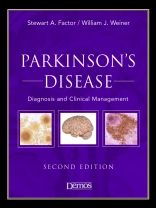Parkinson’s disease (PD) is the second most common neurodegenerative disease in the world. Still the only major text on the subject, the completely revised and updated second edition of Parkinson’s Disease: Diagnosis and Clinical Management comes at a time when specialists have made important advances in our understanding of the etiology, pathogenesis, investigation, and management of Parkinson’s disease.
The book includes 23 completely new chapters, and has updated information on:- Genetics
- Pathology
- Biomarkers
- Pathogenesis
- Impulse control disorders in Parkinson’s disease
- Updated outcome measures
- Complementary and alternative medicine for the treatment of Parkinson’s disease
Together the chapters form a comprehensive review of the many issues facing PD physicians today. Lucid and easily readable from beginning to end, each chapter may also stand on its own as a scholarly review of the individual subject. Each one is concisely written and heavily referenced for this purpose.
The second edition of Parkinson’s Disease: Diagnosis and Clinical Management provides a state-of-the-art review of where we’ve been, where we are now, and where we are going in treating this disease.
Innehållsförteckning
History; James Parkinson: The Man and the Essay; Paralysis Agitans in the Nineteenth Century; Charcot and Parkinson’s Disease; Parkinson’s Disease in the Twentieth Century and Beyond: A Time Line of Important Events; Clinical Presentation; Epidemiology of Parkinson’s Disease; Cardinal Features of Early Parkinson’s Disease; Gait Disturbance; Sensory Symptoms; Voice, Speech, and Swallowing Disorders; Gastrointestinal Features; Autonomic Nervous System Dysfunction; Sleep Disorders in Parkinson’s Disease; Natural History; Clinical Rating Scales; Behavioral and Psychiatric Manifestations; Dementia; The Diagnosis and Treatment of Parkinson’s Disease with Comorbid Mood Disorder; Anxiety and Panic; Apathy and Amotivation; Impulse Control Dysfunction; Pathology and Neurochemistry; Pathology; Neurochemistry; Basal Ganglia Anatomy and Physiology; Dopamine Receptor Diversity; Diagnosis; Problems in Clinical Diagnosis; Status of Biological Markers; Positron Emission Tomography Investigations of Parkinson’s Disease; Single Photon Emission Computed Tomography in Parkinsonian Disorders; Magnetic Resonance Imaging in Parkinson’s Disease; Controversies in Neuroimaging; Pathogenesis; Animal Models of Parkinson’s Disease; Pathogenesis: Oxidative Stress, Mitochondrial Dysfunction, and Excitotoxicity; Programmed Cell Death; Protein Aggregation; Etiology; Etiology: The Role of Environment and Genetics; The Impact of MPTP on Parkinson’s Disease Research: Past, Present, and Future; Rotenone and Other Toxins; Inflammation; Genetics; Drugs; Levodopa: A Pharmacologic Miracle Four Decades Later; Amantadine and Anticholinergics; Monoamine Oxidase Inhibitors; Dopamine Agonists; Catechol-O-Methyltransferase Inhibitors; Excitatory Amino Acid Antagonists; Adenosine A2A Receptor Antagonists in the Treatment of Parkinson’s Disease; Alternative Therapies; Treatment Issues; Motor Fluctuations and Dyskinesia; Fluctuations of Non-Motor Symptoms; Psychosis and Other Behaviors; Treatment of Dimensia; Status on Protective Therapies; Treatment Approaches for Early Disease; Progress in Gene Therapy for Parkinson’s Disease; Genetic Testing and Parkinson’s Disease; Surgery; Deep Brain Stimulation; Neural Transplantation for Parkinson’s Disease: Yesterday, Today, and Tomorrow; Ablative Surgery; Subtypes of Parkinsonism; The Parkinson-Plus Syndromes; Symptomatic Parkinsonism; Social Issues; Disability; Family Caregiving; Economic Impact: Implications for Interventions; Driving; The Patient’s Perspective.
Om författaren
William J. Weiner, MD, Professor and Chairman, Department of Neurology, University of Maryland, Baltimore, Maryland












